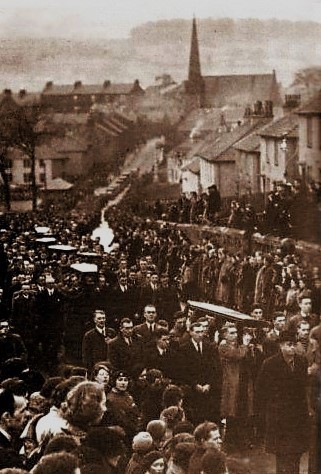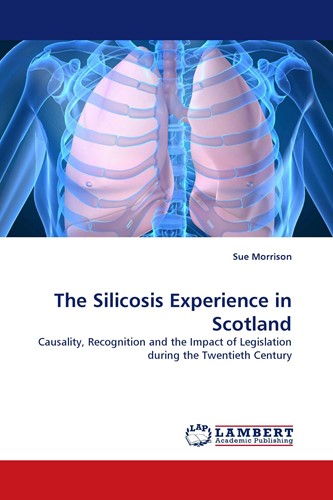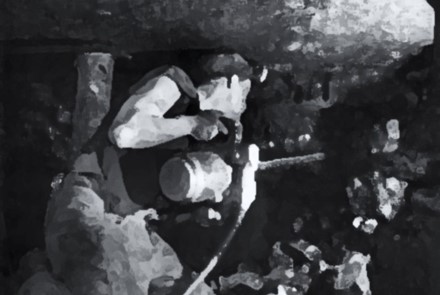Coal Miners: Accidents and Ill Health

MINING ACCIDENTS
Mining accidents referencing ‘Twechar’ between 1899 and 1963 (verbatim). See: http://www.scottishmining.co.uk
NB. More Twechar mineworkers suffered injuries and death but their addresses were not included in the accident reports. Many more suffered and died from occupational illness, including silicosis and coalworkers’ pneumoconiosis – none of these are included here.
Mining Accident Reports
Mining Fatality - John Higney, a miner, residing at 40 Auchinstarry Row, met with an accident which proved fatal in No. 1 Twechar pit on Monday. He was working at the face when a quantity of stones came away from the roof and crushed him severely. On being conveyed home he was attended to by Dr James Park, but the internal injuries were of such a nature that he only survived a few hours. Deceased was 53 years of age. [Falkirk Herald 28 January 1899]
Kirkintilloch Miner Killed - James M'Guire, 40 years of age, pit-drawer at St Flannans' colliery, and residing at Black Bull Close, Kirkintilloch, has been killed while at work. He was buried in a fall from the roof. He was unmarried and resided with his widowed-mother. [Scotsman 12 February 1916]
Croy Pit Fatality - William Law (18), pit bottomer, Barrhill Rows, Twechar, was on Saturday instantly killed in Gartshore No. 1 pit, Croy, belonging to William Baird & Co. (Ltd.) Law had tried to cross the cage at the bottom of the shaft just as it was about to ascend to the surface. He was caught and jammed between the cage and the framework of the shaft. [Scotsman 5 October 1925]
Youth Electrocuted - Kilsyth Pithead Fatality - Hugh Smith (18), apprentice electrician, son of Mr James Smith, colliery manager, 1 Barrhill, Twechar, was on Saturday electrocuted at Messrs William Baird & Co.'s, No. 11 Gartshore Colliery, Croy. Along with another youth, he was on an iron framework connected with the electric, transformers on the pithead, about 15 feet from the ground. He was engaged cleaning the insulators, when he inadvertently touched a live wire, and was instantaneously killed. His clothing was badly burned. His companion immediately dropped to the ground and escaped injury. [Scotsman 21 October 1929]
Croy Pit Fatality - Alexander Truten (16), pithead worker, residing at Twechar, was fatally injured last night while a work at Gartshore No. 3 Colliery, Croy. He had been at work at the coal-washing plant when he was caught by a hutch and so severely injured about the neck and chest that he died almost immediately. [Scotsman 6 May 1933]
Fatal Accident in Twechar Colliery - Walter Irvine, oncost worker, Kingston Flats, Kilsyth, was last night killed, while at work in Twechar Colliery, Eastern Dunbartonshire. He was caught by a fall of material and knocked into water, death being instantaneous. A married man, he was well known in Masonic circles, having been Master of Lodge St John No. 39. John Kennedy, another oncost worker, residing at Kingston Flats, Kilsyth, was also involved in the fall, and received injuries to the head and back. [Scotsman 20 December 1935]
Boy Killed and Father Injured at Twechar, Dunbartonshire - David Boyd, Jun., a lad of 15 years, of Burnbrae, Twechar, Dunbartonshire, was killed in Messrs William Baird & Co.'s Easter Gartshore No. 11 Colliery Croy, on Tuesday night. He had been working alongside his father, David Boyd (42), coal cutting machine man, in a section on the backshift when an explosion took place, the boy being killed outright. The father was severely burned, but succeeded in reaching a telephone and warning the pitheadman. Rescuers who found the boy applied artificial respiration methods for an hour without success. The father was removed to the Royal Infirmary, Glasgow. The day shift lay idle yesterday as a result of the tragedy. [Scotsman 13 February 1936]
Second Death in Croy Pit Explosion - David Boyd, Sen., coal cutting machine man, Burnbrae, Twechar, Dunbartonshire, has succumbed in the Royal Infirmary, Glasgow, to burning injuries received in an explosion in Easter Gartshore No. 11 Colliery, Croy, last week. Deceased, who was 43 years of age, was walking along with his 15-year-old son David when the explosion occurred, the boy being killed instantaneously. The father managed to reach a telephone in the underground workings and inform officials at the pithead regarding the accident. He was immediately removed to the Infirmary, where, as stated, he has died from his injuries. [Scotsman 20 February 1936]
FEATURE: Dumbreck Colliery Disaster - Nine Die in Stirlingshire Mine - Suffocated by Outbreak of Fire in Supporting Woodwork - One Man Crawls To Safety - Three Members of One Family Among the Dead.
Nine men were suffocated in No. 1 pit of Dumbreck Colliery, Kilsyth, Stirlingshire yesterday, as a result of an outbreak of fire. Only one member of a squad of ten brushers, Thomas Martin, the foreman, survived. He was apart from the main group, and when he saw a flash, went to make inquiries. He met his nephew, Joseph Martin, and together they struggled through smoke and fumes for about 400 yards to a main roadway. There Joseph Martin separated from his uncle, doubled on his tracks, and lost his life. Thomas Martin succeeded in reaching the pit bottom and giving the alarm. In addition to his nephew, his brothers Robert and James lost their lives. Harry Hagan, another victim, was a brother-in-law of the Martins. 
The Victims
Joseph Kelly, aged 31. Armiston, Twechar;
Edward O'Neill, aged 23, Manse Road, Kilsyth;
James Martin, aged 42, Smithston Crescent, Croy;
Robert Martin, aged 35, Queenzieburn, near Kilsyth;
Joseph Martin, aged 22, Kirkland Crescent, Kilsyth;
Harry Hagan, aged 35. Manse Road. Kilsyth;
Peter Walker, aged 45, Kirkland Crescent, Kilsyth;
Peter Byrne, aged 23, Kingston Flats, Kilsyth;
Joseph Campbell, aged 56, Jarvie Crescent, Kilsyth.
Most of the men were married.
The mine where the fire occurred, owned by William Baird & Co. Ltd.. coal masters. Glasgow, is a well-known landmark off the main Glasgow-Stirling roadway. There are two pits and normally they give employment to about 300 men. The fire occurred in No. 1 Pit, where coking coal, which is regarded as the cleanest of fuel, is mined. The pit goes to a depth of over 1200 feet and where the accident occurred lies about a mile and a half from the pit bottom. Brushers attend to the road and roof and clear up generally after miners have taken out the coal. The men involved were employed by a contractor in preparing the section for the night shift miners. A blinding flash followed by dense fumes, which quickly permeated the roadway, provided the prelude to the disaster, the worst of its kind in Mid Scotland for a number of years. Thomas Martin was separated from his workmates, and after the flash he decided make for assistance. Within a few seconds the roadway was filled with blinding smoke, and he struggled in the direction of the main road way. His nephew joined him, and on hands and knees they crawled along the muddy roadway for a few hundred yards before reaching an intersection. The young man went off in the wrong direction, while his uncle groped his way to a clearer atmosphere, ultimately reaching the pit shaft in a state of collapse, he told the pit officials what had happened, and within a short time issue squads were being organised.
Summons To Rescuers - The two electricians who received the telephone message from Martin were James Wilson and William Patrick. They were working near the shaft bottom, and on receipt of the message they ran in the direction of the fire. News of the disaster quickly spread throughout the district, and many miners volunteered for rescue work. The rescue brigades at Coatbridge were summoned, and in view of the dangerous nature of their task, the name and number of each rescue worker were taken as he went down the nine. Gas masks and oxygen apparatus were provided, and local doctors were summoned to be in readiness. Police from the surrounding districts hurried to the pithead to render assistance. By five o'clock hundreds of people were in the vicinity, anxiously awaiting news of the happenings underground. There were many touching scenes as women relatives of the men involved, overcome with anxiety, broke down. The suspense became more acute when it was learned that the progress of the rescue brigades had been impeded by a heavy fall of stone and that blasting was necessary to clear the roadway. Shortly after eight o'clock the worst fears of the onlookers were realised, when the first of the bodies was conveyed from the pithead to one of the sheds A hush fell over the crowd. Women wept. Little information, however, could be obtained, and it was fully an hour later before it was learned that all the entombed men had lost their lives through suffocation. The trapped men had apparently made a brave bid for life, attempting to dash through the flame-scorched roadway.
Survivor's Account - Thomas Martin, who received attention at the pithead, was in so distressed a condition that he could give only a vague account of what had happened. He said he had the first indication that something was amiss when he saw smoke coming from the pit props. He rushed to a telephone, told the firemen that he feared fire had broken out, and then went back to see if he could warn the other men. He took an hour to get along the mile and a half of roadway to the shaft, and was overcome four times by the smoke. He held his breath when passing the smoking timbers in an effort to conserve his energy.
Task of the Rescue Squads - Representatives of The Scotsmen who arrived at the pit in the late afternoon gained some idea of the task which lay ahead of the rescue squads. Attired in special steel helmets and wearing respirators, the rescuers descended the shaft in batches, and took with them chemical extinguishers and sand. When they arrived at the pit bottom, they found the air was bad, and had to use their masks. Walking slowly along the main roadway, they had extreme difficulty in picking their way through the smoke which resembled a white mist. Their work was further hampered by a fall from the roof, and it was found necessary to blast the rock away in order to clear a passage. The fire which raged in the affected area, known as the north section of the coking coal, No. 1 Pit, made progress impassible, and, working in relays, the men passed bags of sand along to each other, and then threw the sand on top of the burning props in an effort to smother the smouldering woodwork. The chemical extinguishers were brought into use, and a continuous supply of sand and refilled extinguishers were sent from the pithead. After working for several hours in the pit. the rescuers, who were under the charge of instructors, returned to the surface, while others took their places. Realising the impossibility of cutting through the fire in time to rescue their trapped comrades, the squads worked round the affected area, confining the outbreak to a restricted portion of the workings. When the rescuers stated that the coal did not catch fire, the smell being that of burning wood. The first body found was only a few yards from fresh air and safety.
Died Near Clear Air - Another stated:- “We found the first body at 8.15 p.m., and the other shortly afterwards All the men were dead, having been suffocated. Most of the bodies were found within 200 yards of clear air, and they had evidently tried to dash through the fire, instead of attempting to make a detour round the blazing pit-props. The fire was confined mainly to the pit-props , and the wood with which the brushers make up the roadway, the roof, and walls. This wood had all burned out, and fallen down on the roadway. When we found the bodies there was just a light fog in the vicinity."
The bodies of the victims were removed from the mine early this morning. When the first call for rescue workers was made, there were more volunteers than could be employed. The rescue gear included piping, which was led down the shaft to enable water to be conducted along the haulage road. Electric fans were also brought into use to clear the smoke from the affected area. As they worked at high pressure they threw up a tall pillar of smoke from the ventilator shaft. The rescue parties were also hampered by the extreme heat near the heart of the fire. Among the officials who were early on the scene were Mr William M'Alpine, Messrs William Baird & Company's agent; Captain Buchanan, the local general manager, who descended the pit; along with Mr Stoker and Mr Hoyle, H.M. Inspectors of Mines.
A drawer in the pit, Robert White, said he was working by the shaft when the alarm was raised. Along with others he went to the surface, but later descended the shaft to assist in the rescue work. "When we got to the scene of the accident , the pit props were blazing, and it was impossible to do anything. The fire was about nine feet high by about twelve feel across, and the haulage road was completely blocked." He did not think that the trapped men could have much space to retreat from the smoke, and added that they were probably suffocated within a comparatively short time.
There were distressing scenes at the surface, although the menfolk waiting at the pithead to identify relatives stoically hid their feelings. A railway embankment which runs alongside the pit was thronged with spectators, while doctors and ambulance waggons stood by. Special police were drafted to the scene to keep back spectators from the surface workings. Union officials were also in attendance, while the Lanarkshire Coalmasters' Association sent out their ambulance and rescue equipment car to the scene. In the evening, while the relatives of the victims stood at the pithead, a shower of sleet and snow, and intermittent falls of heavy rain, made conditions most unpleasant.
Father of Five Children - By the death of Robert Martin, a widow and five young children have been left. One of the children, a neighbour stated, was recently severely burned, while Mrs Martin, who had been in Stirling Infirmary, had to use crutches for over two years as the result of an accident.
Mrs Martin, mother of Joseph Martin, was in a state of collapse, and was led away from the pithead by sympathisers. By the death of her son she has now lost three members of her family in pit accidents, her husband and another son having also died in the pits. Sam Hagen, calling at the pit on learning that there had been a disaster, was informed that his brother was one of the entombed men. " Harry," he said to a reporter, "was married and had a family of three. I work in another pit, and this month has been one of ill-fortune for our family. At the beginning of the year my little girl was taken suddenly ill and died. I looked upon that as an ill omen for the New Year, and now before the end of the month I have lost my brother." [Scotsman 31 January 1938]
Two Lives Lost in Fire – Gartshore Colliery Outbreak – Missing Man Found Alive - Two men lost their lives as a result of an outbreak of fire early yesterday morning in the underground workings of Easter Gartshore No. 11 Colliery, situated in the Croy district of Dunbartonshire. The colliery belongs to Bairds and Scottish Steel, Ltd. The men were in a party of brushers and repairers numbering between 20 and 30 men engaged at work in various parts of the colliery workings. Those who lost their lives were: William Burns (50), repairer, who resided at Newtown Street, Kilsyth (a widower); and Richard O'Raw (28) repairer, of Shuttle Street, Kilsyth (unmarried). A third man who was reported missing was found alive by a rescue party after a search extending over eleven hours. [Scotsman 31 May 1940]
Two Miners Suffocated - Scottish Colliery Fire - Two men were suffocated in a fire at a section of Gartshore Colliery, Croy, Dunbartonshire, early to-day. They were Richard O’Raw, 26, and William Burns, 49, both of Kilsyth. Firefighting and rescue squads worked all night; and all but the three men reached safety. Rescue teams recovered the bodies. The colliery is owned by Bairds and Scottish Steel, Ltd. The escape of 17 miners attributed to the pluck and resource of Pat McGarry, of Twechar He gathered a team of men from a section in the colliery not affected by the outbreak; and they were able to assist all but the three victims to safety. [Nottingham Evening Post 31 May 1940]
Three Die in Colliery Fire – Three men were suffocated in a fire at a section of Gartshore Colliery, Croy, Dunbartonshire, early to-day They were: Richard O’Raw 27 and William Burns, 66, both of Kilsyth and Archibald Cairns, 40, married with large family, of Twechar. Rescue teams recovered the bodies. [Hull Daily Mail 31 May 1940]
NK (Twechar area) Stirling: Thomas Airlie, 38 coalmining deputy struck by steel instrument (August 6 1963)
Auchengeich Pit Disaster, 18th Sept 1959 Please see: http://www.scottishmining.co.uk/250.html
 MINERS' HEALTH
MINERS' HEALTH
‘Throughout the twentieth century the experience of extracting coal mirrored that in the quarry industries on many levels. Both involved highly dangerous working conditions with each having an unenviable record of accidents and ill health. Both involved the winning of natural resources by means of explosives, drilling and cutting. And both industries exposed workers to very hazardous materials, including silica dust. However, the disease differed in coalminers, most obviously in the colour of the phlegm coughed up by the workers and, critically, in the pathological findings of diseased lungs. The presence of silica, officially recognised as the cause of lung disease, was not always as evident in men whose lungs were pitch black with mine dust as it was in quarriers with white lungs resembling stone. During the 1920s and 1930s, if coal miners could prove that they had worked in high silica-content seams, in processes officially decreed as hazardous, those with evidence of silicosis might be eligible for compensation. Extensive research during the 1940s eventually found that serious pulmonary disease occurred in workers exposed to dust in which the percentage of free silica was low. This was an important step forward but was overshadowed by the recognition that coal dust was, in its own right, a major cause of pulmonary disease amongst coalworkers. Many years had passed before coal dust was recognised as harmful and many more decades passed before low levels of the most hazardous element of coal, silica, was re-acknowledged as a cause of rapid progressive massive fibrosis in coal workers. High silica-content dust was easier to recognise in coalworkers, particularly in the anthracite coal fields of Wales, where investigators determined in 1942 that: ‘If the dust contains a high proportion of free silica in a fine state of division, the disease tends to develop rapidly.’ In 2003, Buchanan, Miller and Soutar of the Institute of Occupational Medicine, Edinburgh, concluded that the risks of silicosis over a working lifetime could rise dramatically with even brief exposure to high quartz concentrations. The problem for coalworkers was that almost every aspect of work involved exposure to mine dust that was a mixture of coal and silica, with some processes being more hazardous than others.’
Source: Dr Sue Morrison, The Silicosis Experience in Scotland: Causality, Recognition and the Impact of Legislation during the Twentieth Century, LAP Lambert Academic Publishing (Saarbrucken, Germany, 2010). Extract shown here with permission from the author.
